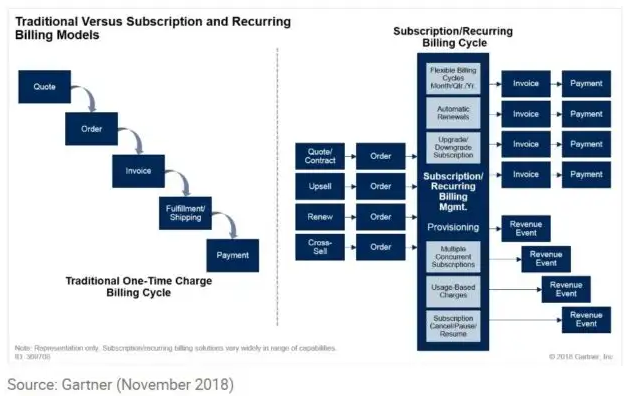Quick Guide To Subscription Management
An introduction to subscription management software and how it can help your business.

Subscription business sales have grown substantially faster than two key public benchmarks—S&P 500 Sales and U.S. retail sales. Technology is developing at a rapid pace and finance teams are at the front of the new subscription economy. What parts of subscription management are most important for finance, and what software is giving finance the edge? This quick guide gives you the answers.
What is subscription management?
Subscription management is a process for managing customers from the time they subscribe to a product or service until they cancel their subscription.
A subscription is a contract between a buyer and seller for a recurring payment for a good or service.
There are examples of subscription business models in almost every industry: from magazine publishing, to streaming services, food delivery, lawn care, software systems (software as a service) and more.
In subscription businesses, the finance team is usually responsible for measuring recurring revenues and managing financial processes related to invoicing, reporting, revenue recognition, accounting and cash management. These processes are different, and often more complex than in traditional businesses with one-off payments.
For this reason, finance professionals use specialized tools, techniques and processes to track revenues and monitor financial health. In fact, an entire new category of software has emerged specifically to support financial operations in subscription businesses. It's called subscription management software.
CFOs and finance teams use subscription management software to forecast and measure revenues, manage invoicing and payments, and keep an eye on cash-flow. These modern systems organize data, automate reporting and provide finance with insight about growth and profitability.
Why does subscription management matter?
Subscription management solutions are key to managing recurring revenues, optimizing pricing strategies, monitoring key performance indicators (KPIs) and many other activities.
Let's take a look.
Manage revenues
Subscription businesses often measure recurring revenues in terms of monthly recurring revenue (MRR) and annual recurring revenues (ARR). These measurements are easy for finance and accounting to calculate in theory, but more difficult in practice.
Consider what happens when a customer upgrades his/her subscription, or cancels their agreement all together. Perhaps they want to pay annually instead of monthly. Maybe they want to stop their subscription during the summer holiday.
How can finance teams manage these changes? How will invoices be updated? How will forecasts and revenue recognition be adjusted? The more customers there are, the more complicated it becomes. Businesses with multiple subsidiaries are in an even more challenging situation if they don't have effective systems and processes in place.
The below diagram illustrates some of the complexities of managing recurring revenues:

Illustration: Subscription management software helps businesses manage revenues throughout the customer life cycle. Source: Gartner.
Manage price adjustments
Another reason for subscription management software is that it enables businesses to manage processes related to price changes. Pricing flexibility is critical to growth companies who are trying to optimize their revenues.
When a business increase base prices, for example, the software recalculates revenues and adjusts billing automatically. Doing this manually would take days or weeks of calculations. Worst case scenario is when a company is unable to raise prices or change pricing models because the cost of implementing the change is greater than the benefit.
Monitor KPIs
The third important reason for subscription management systems, is that they are specialized at capturing data and reporting KPIs. Many recurring revenue businesses are 'obsessed' with KPIs, and rightly so.
Understanding the underlying factors driving MRR and ARR, is critical to success. Subscription management systems normally break down MRR into the following components:
1. New MRR: New MRR is the monthly recurring revenue that's generated from brand new customers.
2. Expansion MRR: The amount of monthly recurring revenue generated from existing customer through up-sell or cross-sell
3. Churn MRR: Revenue that's been lost due to customers canceling.
4. Contraction MRR: Revenue that has been lost due to downgrades or reductions.
Subscription management systems normally break down ARR into the following components:
- Total ARR Growth including acquisitions
- Organic ARR Growth excluding the effect of acquisitions
- New sales ARR Growth, which only includes new sales
Analytics based on data in subscription management data enables leaders, board members and investors to understand profitability and growth. In highly competitive industries, data-driven insights can make the difference between bankruptcy or survival. Subscription management tools give businesses the extra edge.
What are the components of a subscription management system?
The components (and functions) of a subscription management system vary significantly depending on the vendor. Some systems cater to B2B subscription businesses who sell direct or through partners, for example, while other systems are made for large e-commerce businesses.
For B2B market, these are a few of the common components:
- Central register of contact details
- Central contract storage
- Pricing plans
- Product purchases
- Trials, up-sell, cross-sales or contractions
- Termination, pauses, cancellation
- Discounts
- Invoicing/payment information
- Dashboards and reports
- Change log/history
How to tell if you need a subscription management tool?
There are many good reasons to invest in a subscription management system. If you want better insight into growth and profitability, your finance department is struggling to keep up, or you have problems with any one of the following areas, then considering a subscription management tools should be your next step:- Spend hours on tedious, manual routines
- Overwhelmed by complicated spreadsheets
- Frustrated with your current processes and systems
- Time consuming data import/export
- Struggle to adjust prices/ implement new price models
- Spend hours calculating MRR, ARR, and other KPIs
- Difficulty explaining reasons for revenue growth/shrinkage to your board
- Lack visibility into your sales forecast or cash flow
- Repeated problems with invoice accuracy
- High growth or acquisitions and need to scale or expand quickly